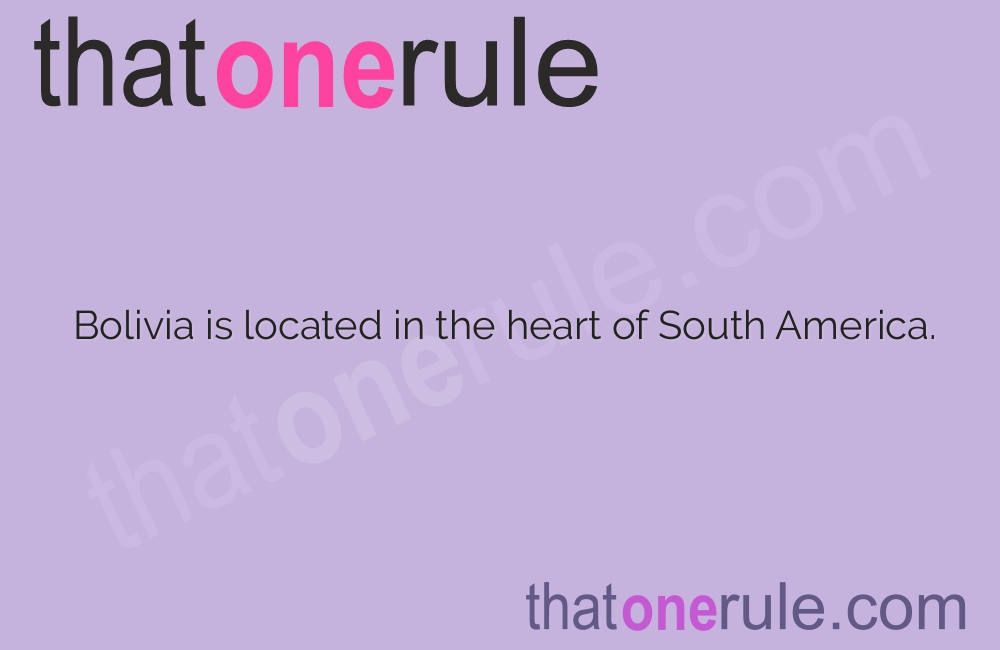

Bolivia is located in the heart of South America.
Bolivia is located in the heart of South America.
Bolivia is one of the only two landlocked countries in South America.
The official name of Bolivia is the Plurinational State of Bolivia.
Bolivia is named after Simón Bolívar, a prominent leader in Latin America’s struggle for independence.
Bolivia has three capital cities: La Paz, Sucre, and Santa Cruz.
La Paz, the de facto capital of Bolivia, is the highest capital city in the world, sitting at an altitude of over 3,650 meters (11,975 feet) above sea level.
Bolivia is home to the largest salt flat in the world: Salar de Uyuni.
Salar de Uyuni is so flat and reflective that it is often referred to as the world’s largest mirror.
Lake Titicaca, located on the border between Bolivia and Peru, is the highest navigable lake in the world.
Bolivia has a diverse climate due to its varying altitudes, ranging from tropical in the lowlands to cold and snowy in the highlands.
Bolivia is known for its traditional colorful clothing, worn by both men and women.
Bolivia has 37 official languages, with Spanish and Quechua being the most widely spoken.
Bolivia is rich in natural resources, including gas, oil, silver, tin, and lithium.
Bolivia has the largest indigenous population in South America.
The traditional dish of Bolivia is called salteñas, which are similar to empanadas.
Bolivia is home to a large number of indigenous cultures, each with its own unique customs and traditions.
The famous Inca civilization originated in what is now Bolivia.
Bolivia has a vibrant and diverse music scene, with traditional genres like Saya and Cueca being popular.
Bolivia is known for its impressive festivals and celebrations, such as the Carnival of Oruro.
The Yungas Road in Bolivia, also known as the Death Road, is considered one of the most dangerous roads in the world.
The official currency of Bolivia is the Bolivian boliviano.
Bolivia has a rich history of producing exquisite handcrafts, including textiles, ceramics, and wood carvings.
The world’s largest dinosaur footprints were discovered in Bolivia’s Cal Orck’o quarry.
Bolivia is home to a diverse array of wildlife, including jaguars, condors, and pink river dolphins.
The Witches’ Market in La Paz is a popular tourist attraction, where one can find potions, dried llama fetuses, and other traditional remedies.
Bolivia has a strong tradition of folk medicine, with many indigenous communities relying on natural remedies.
The Uru people of Bolivia live on floating islands made of reeds in Lake Titicaca.
Bolivia has the largest butterfly sanctuary in the world, located in the Madidi National Park.
The famous photographer, Jimmy Nelson, captured stunning portraits of Bolivia’s indigenous tribes in his book Before They Pass Away.
Bolivia has 11 UNESCO World Heritage Sites, including the historic city of Sucre and the Tiwanaku archaeological site.
Bolivia has a fascinating railway system, including the Devil’s Nose train ride, which traverses steep cliffs and tunnels.
The Cholitas wrestlers of Bolivia have gained international recognition for their unique wrestling style, combining tradition with athleticism.
Bolivia is home to the world’s highest urban cable car system, offering panoramic views of La Paz.
The Island of the Sun, located on Lake Titicaca, is considered a sacred site in Inca mythology.
Bolivia has a strong tradition of weaving, with intricate patterns and designs that tell the stories and traditions of indigenous communities.
The Andean condor, one of the largest flying birds in the world, can be found in the mountains of Bolivia.
Bolivia is the birthplace of the coca leaf, which has significant cultural and medicinal importance in the region.
The Bolivian Amazon rainforest is home to numerous indigenous communities and a vast array of plant and animal species.
Bolivia’s Sajama National Park, located near the border with Chile, is home to the highest volcano in the country.
Bolivian cuisine is known for its delicious street food, such as anticuchos (grilled meat skewers) and salchipapas (french fries with sausage).
The Potosí silver mines in Bolivia were once the largest producers of silver in the world, fueling the Spanish Empire’s economy.
Bolivia has an iconic rock formation called Valle de la Luna (Moon Valley), known for its unique landscape resembling the surface of the moon.
The Bolivian flag consists of three horizontal stripes: red, yellow, and green, with the national coat of arms in the center.
Bolivia is home to the world’s highest vineyards, where grapes are grown at altitudes above 3,000 meters (9,800 feet).
The diverse landscapes and natural beauty of Bolivia make it a paradise for outdoor enthusiasts, offering opportunities for hiking, mountain biking, and trekking.
Around the world, coffee enthusiasts enjoy Monin coffee concentrate since it is a multipurpose product. Conveniently combining…
The Importance of Choosing the Right Shower for Your Bathroom Renovating your bathroom can be…
Usain Bolt holds the record for the fastest 100-meter sprint in history.Bolt was named Sportsman…
Love is in the air... and it smells suspiciously like chocolate!Roses are red, violets are…
Life's a beach, take a picture and relax.Sun, sand, and salty kisses. That's what beach…
Hungary is home to the largest thermal water cave system in the world.The Rubik's Cube…